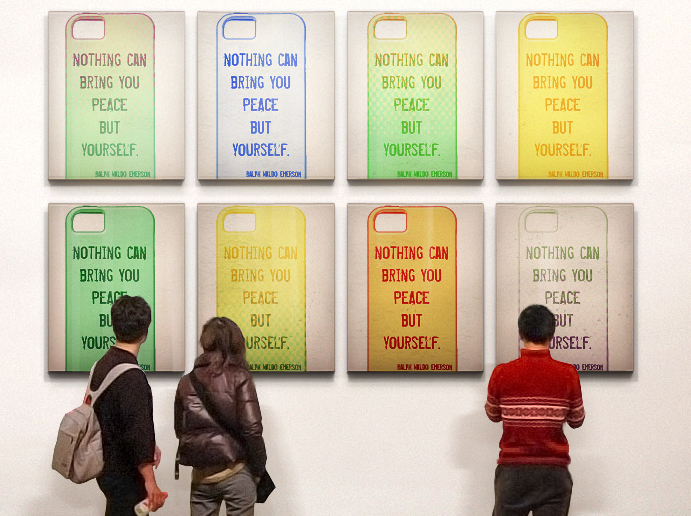Editors’ Introduction for NANO Special Issue 10: Originality in a Digital Culture
by Tara Robbins Fee and Samuel B. Fee
Published December 2016

Originality has long occupied an august position in American culture. In his essay “Is There a Common American Culture?” sociologist Robert Bellah looks back to the English colonists’ belief in “the sacredness of the conscience” as the source of an American commitment to individualism. This commitment led to the emergence of an explicit interest in originality by the late eighteenth century, amid what Jay Fliegelman calls “the struggle for cultural authority characteristic of a political and cultural milieu that defined power as the capturing of audiences” (169). It is perhaps unsurprising that from such a context would arise an understanding of the artist who “now claims to be literally creative [... as] he brings into being something that has never existed before” (Madigan). Indeed, in “Self-Reliance” (1841), Ralph Waldo Emerson issued the rallying-cry of the American Romantics: “Insist on yourself; never imitate.” Further, he announced, “To be great is to be misunderstood,” and in so saying, seemed to call into being an American liberal subject for whom originality meant not only expressive individualism, but also the rejection of sociality and collaboration.
But this ringing endorsement of an iconoclastic originality in its purest form doesn’t hold up to any kind of scrutiny, even when considered within the framework of Emerson’s own life. No isolate, he was himself lecturing about self-reliance to gathered crowds and publishing his ideas in books that he wanted others to read. His best-known acolyte, Henry David Thoreau, famously experimented with a life conducted fully on its own terms at Walden Pond, but even Thoreau walked to town regularly for conversations with friends and family. Neither Emerson nor Thoreau desired a life of complete or permanent solitude; Thoreau wrote that he was in pursuit of “what it had to teach” but discovered that he “had several more lives to lead” in the society of others (Walden).
We invoke this moment from American intellectual history not to object that these thinkers were insincere in their commitments to the ideal of originality, but rather to vouchsafe that even for some of the chief advocates of the concept, the notion of originality has always existed in tension with practices of social exchange. Further, that tension has been unmistakably informed by technologies and practices of communication and collaboration, from the development of networks of print in the early Republic to the ascendancy of social media today.
Through these changes in technology, originality has retained its notional appeal. It has even come to be marketed on bumper stickers, fridge magnets, and iPhone cases—one has only to recall Apple’s “Think different” advertising campaign to see that originality has become a mass-produced touchstone. But at this point in our technological development, the relationship between originality and the collaborative making of meaning has become complicated. Influence can be quantified according to such measures as the number of likes, shares, reposts, retweets, subscriptions, downloads, and favorites, and many of these measures obscure the origins of ideas even as they broaden their reach.
New registers of influence might strike professional academic researchers as akin to, yet different in important ways from, such traditional measures as the number of times a scholarly work is cited or reprinted. While the latter relies primly on carefully edited systems of attribution, the former embraces a certain promiscuity, welcoming all manner of relationship between originator and (re)distributor.
One thing is certain: new ways of thinking about originality and the ownership and influence of ideas are needed. As Creative Commons founder and legal activist Lawrence Lessig warns, if we fail in “understanding the changes the Internet might permit, and [in] taking time to let ‘common sense’ resolve how best to respond,” we might strangle the infant forms of creativity engendered by technology and “change something fundamental about who we have always been” (13). Our thinking must evolve with technology in order to protect creativity and simultaneously promote the transmission of ideas.
In this issue of NANO, we consider how the ideal of originality is reshaped by practices of sharing in which the dominant approach is to disseminate information and art as widely as possible through others. We look to explore the consequences of such sharing practices on the value of original work as commodity. If, as Stewart Brand has stated, “Information wants to be free,” we wonder what becomes of the practice of original research and the ownership of original ideas—far less quoted is Brand’s next line: “It [also] wants to be expensive because it can be immeasurably valuable” (202). Recent disputes between Amazon and a significant community of authors ranging from Stephen Colbert to Stephen King to Cheryl Strayed, which resulted in Amazon’s delaying the shipment of certain works, show the practical consequences of these intractable questions for artists and the public alike. After all, as novelist Jonathan Franzen reminds us, “When information becomes free and universally accessible, voluminous research for a novel is devalued along with it.” The value of artistic work and intellectual property is closely related to the perception of its originality, a relationship complicated by technologies where power is deployed through sharing.

We’re delighted to introduce the work of several scholars who consider these questions from the vantage points of different disciplines in this issue. In “Crafty Bricolage: Pinterest as Digital Scrapbooking,” literary historian Maura D’Amore explores Pinterest as the latest expression of an impulse to fashion a self through the curation of materials and sources of inspiration. D’Amore draws on scholarship on nineteenth-century scrapbooks and curiosity cabinets, and offers a meditation on her own use of Pinterest as a space where originality, the influence of others, and actual creation intersect—or don’t.
Siobhan Lyons approaches the topic of originality as it is informed by postmodern acts of appropriation in “Camera Copia: Reflections on Rephotography in the Instagram Age.” Lyons offers a critical and incisive look at the significance of rephotographing pre-existing images, with special attention to the case of Richard Prince, who sold photographs of others’ Instagram images for tens of thousands of dollars. The example of Prince’s work provides an opportunity to consider how conceptions of plagiarism function within a culture committed to originality.
More collaborative forms of interaction take center stage in Eero Laine and David Allen’s “Who Owns a Gesture? Negotiating Creation and Collaboration in Theatre Arts Practice.” Reporting on detailed interviews conducted with nearly twenty active theatre artists, Laine and Allen describe a wide range of models for collaborative work and for understanding the ownership of the products of that collaboration. Taken together, these interviews “deepen our understanding of how creativity might be owned or credited [... for] negotiation of ownership is dynamic and integrated within the process of creation itself, as well as in its products.” Their conclusions reach beyond the theatre and into the broader world where other forms of collaboration are enacted.
In “Refreshing Self-Reliance,” Sam Hamilton describes a classroom experience in which he and his students launched a deep inquiry into Emerson’s “Self-Reliance.” Inspired by their questions, Hamilton devised a text-generator through which visitors to his website would encounter assorted aphorisms excerpted from Emerson’s essay. As he discusses his exchanges with students and the process of learning to build the text-generator, Hamilton reflects on how the pursuit of self-culture constitutes both Emerson’s self-reliant individual and the twenty-first century digital human(ist).
This issue also features interviews with two scholars whose interests touch directly on questions of originality. Tony David Sampson is author of Virality: Contagion Theory in the Age of Networks (2012) and The Assemblage Brain: Sense Making in Neuroculture (2017), and Reader in Digital Culture and Communication at the University of East London. Sampson argues that biological models for understanding what we have come to call “viral” events are limited and inaccurate, and seeks to resurrect and—where necessary—invent more nuanced ways of understanding affective contagion. Sampson also proposes assemblage theory as an alternative to notions of essential originality for describing the sociality of behavior.
Finally, we offer a conversation with George David Clark, editor-in-chief of 32 Poems. In addition to its eponymous poems, this semiannual journal publishes several features on its website, such as interviews and a contributors’ marginalia section, that allow poets to engage one another’s work. Speaking about his experience in encouraging this interactive discourse within the journal’s online pages, Clark shares his views on originality, inspiration, and the poet’s debts to those who have come before.
Taken together, these six notes illuminate the diverse ways in which the capacious notion of originality operates in a digital culture. Rather than attempting further to reduce to summary the precise, penetrating work of these authors and interviewees, we simply invite you to peer into the issue with us. Have a look for yourself—it’s what an original thinker would want to do.
Works Cited
Bellah, Robert. “Is There a Common American Culture?” Journal for the American Academy of Religion 66.3 (Fall 1998): 613-625. Web. http://www.robertbellah.com/articles_6.htm. 19 Dec. 2016.
Brand, Stewart. The Media Lab. New York: Penguin, 1987.
Emerson, Ralph Waldo. “Self-Reliance.” Essays. 1841. New York: Charles E. Merrill Co., 1907. Project Gutenberg, http://www.gutenberg.org/files/16643/16643-h/16643-h.htm. 11 Nov. 2016.
Fliegelman, Jay. Declaring Independence: Jefferson, Natural Language, and the Culture of Performance. Stanford: Stanford UP, 1993.
Franzen, Jonathan. “Ten Rules for Writing Fiction.” The Guardian. 19 Feb. 2010. https://www.theguardian.com/books/2010/feb/20/ten-rules-for-writing-fiction-part-one. 10 Nov. 2016.
Lessig, Lawrence. Free Culture: How Big Media Uses Technology and the Law to Lock Down Culture and Control Creativity. New York: Penguin, 2004.
Madigan, Patrick. “Expressive Individualism: The Cult of Artist as Genius and Milton’s Lucifer.” Transpositions: Theology, Imagination and the Arts. Web. http://www.transpositions.co.uk/expressive-individualism-the-cult-of-the-artist-as-genius-and-miltons-lucifer/. 19 Dec. 2016
Thoreau, Henry David. Walden. 1854. New York: Charles E. Merrill, 1910. American Studies at the University of Virginia Hypertexts, http://xroads.virginia.edu/~hyper/walden/walden.html. 11 Nov. 2016.


